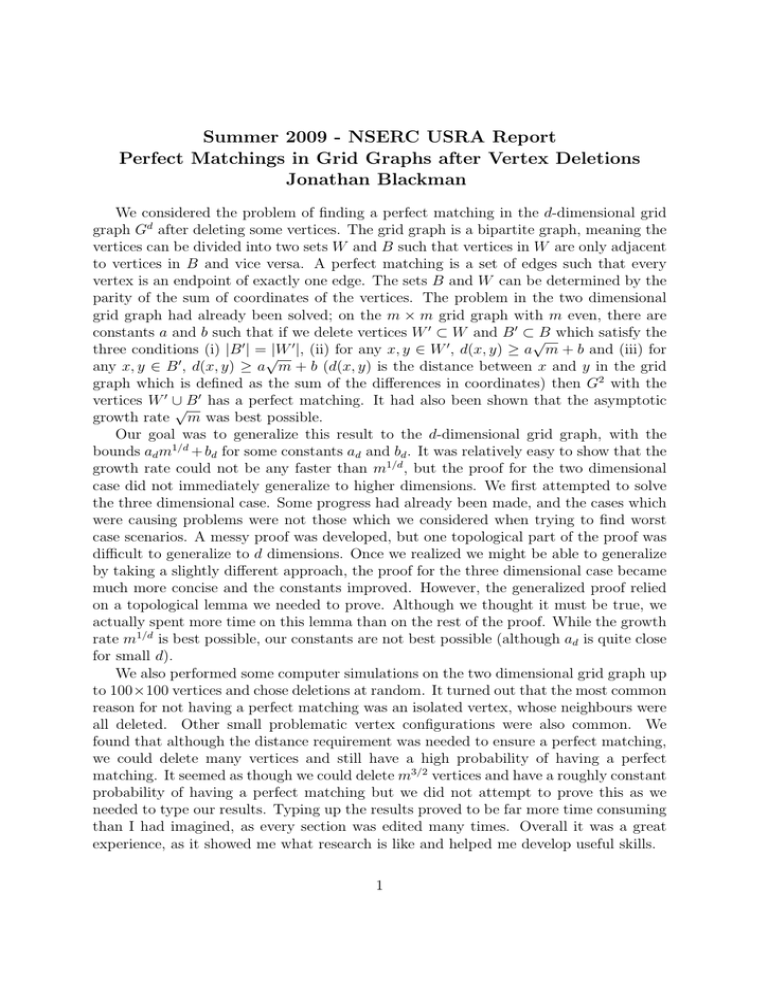Summer 2009 - NSERC USRA Report Jonathan Blackman
advertisement

Summer 2009 - NSERC USRA Report Perfect Matchings in Grid Graphs after Vertex Deletions Jonathan Blackman We considered the problem of finding a perfect matching in the d-dimensional grid graph Gd after deleting some vertices. The grid graph is a bipartite graph, meaning the vertices can be divided into two sets W and B such that vertices in W are only adjacent to vertices in B and vice versa. A perfect matching is a set of edges such that every vertex is an endpoint of exactly one edge. The sets B and W can be determined by the parity of the sum of coordinates of the vertices. The problem in the two dimensional grid graph had already been solved; on the m × m grid graph with m even, there are constants a and b such that if we delete vertices W 0 ⊂ W and B 0 ⊂√B which satisfy the three conditions (i) |B 0 | =√|W 0 |, (ii) for any x, y ∈ W 0 , d(x, y) ≥ a m + b and (iii) for any x, y ∈ B 0 , d(x, y) ≥ a m + b (d(x, y) is the distance between x and y in the grid graph which is defined as the sum of the differences in coordinates) then G2 with the vertices W 0 ∪√B 0 has a perfect matching. It had also been shown that the asymptotic growth rate m was best possible. Our goal was to generalize this result to the d-dimensional grid graph, with the bounds ad m1/d + bd for some constants ad and bd . It was relatively easy to show that the growth rate could not be any faster than m1/d , but the proof for the two dimensional case did not immediately generalize to higher dimensions. We first attempted to solve the three dimensional case. Some progress had already been made, and the cases which were causing problems were not those which we considered when trying to find worst case scenarios. A messy proof was developed, but one topological part of the proof was difficult to generalize to d dimensions. Once we realized we might be able to generalize by taking a slightly different approach, the proof for the three dimensional case became much more concise and the constants improved. However, the generalized proof relied on a topological lemma we needed to prove. Although we thought it must be true, we actually spent more time on this lemma than on the rest of the proof. While the growth rate m1/d is best possible, our constants are not best possible (although ad is quite close for small d). We also performed some computer simulations on the two dimensional grid graph up to 100×100 vertices and chose deletions at random. It turned out that the most common reason for not having a perfect matching was an isolated vertex, whose neighbours were all deleted. Other small problematic vertex configurations were also common. We found that although the distance requirement was needed to ensure a perfect matching, we could delete many vertices and still have a high probability of having a perfect matching. It seemed as though we could delete m3/2 vertices and have a roughly constant probability of having a perfect matching but we did not attempt to prove this as we needed to type our results. Typing up the results proved to be far more time consuming than I had imagined, as every section was edited many times. Overall it was a great experience, as it showed me what research is like and helped me develop useful skills. 1






